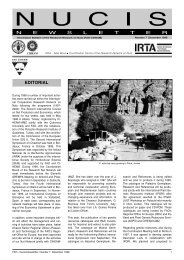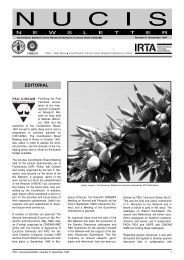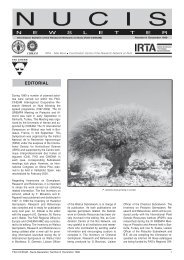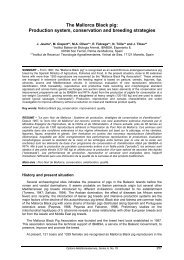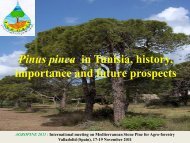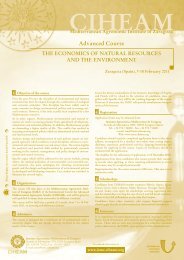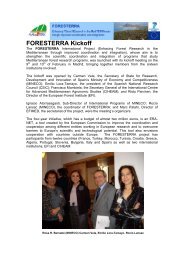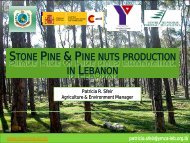MATERIALS AND METHODSType I (all branches bore a mixture ofmale and female infloresences) and TypeII (a tree has several branches with onlystaminate flowers, while the rest of thebranches bore pistillate inflorescences)monoecious trees found by Kafkas et al(2000) are the main materials of this study.Figure 1 shows some pictures fromthe <strong>full</strong>y monoecious tree (Type I). Thesetrees were used both as female and maleparents in this study. Additionally, two femaleP. vera cultivars (cvs ‘Siirt’ and‘Ohadi’) with a dioecious female P. atlanticatree as maternal tree, and dioeciousmale P. vera and P. atlantica trees wereused as pollinators. Totally, twenty differentcrosses were performed betweenfive female and four male parents.Before the stigma becomes receptive, femaleinflorescences were closed with apaper bag (Figure 1D). To collect pollenfrom male parents for artificial pollination,staminate branches of four pollinatorswere cut and put in water-containing potsin the laboratory to perform pollen tests andcross-pollination. In the following two days,pollen was collected and stored at -20 0 Cuntil pollination. Wheat flour was used as amixing agent with pollen at a ratio of 1:1.The harvested nuts were stratified for 60days and then they were germinated inthe greenhouse. Germinated plantletswere transplanted into the five liter plasticbags. The plants were transplanted to theorchard in the autumn of 2003 and dripirrigation is to be set up in <strong>2004.</strong>Besides artificial pollination, the parentsused in this study were described morphologically.The progenies between P.atlantica genotypes and four pollinatorswere also characterized. The distributionof male/female branches/inflorescencesin the monoecious trees was observedyear to year by labeling them within thetree as well. When the progenies will reachthe reproductive stage, they would betested for their sex type, and they will beused as breeding parents to try to obtainmonoecious cultivated pistachios withhigh quality nuts. The segregating populationswill also be used to understandsex mechanism in Pistacia and will beused for molecular studies to clonegene(s) that are responsible for sex determination.Figure 1. (A) The <strong>full</strong>y monoecious P. atlantica tree, (B) a view from branches of the <strong>full</strong>y monoecious tree(F: pistillate inflorescences, M: staminate inflorescences), (C) close up view of the staminate and pistillateinflorescences in a branch, (D) P. vera cv Siirt cultivar tree with bagged branchesRESULTS AND DISCUSSIONArtificial pollination was made duringthree years. In 2001, the crosses betweenP. atlantica and four pollinators, in2002 the crosses between P. vera andthe pollinators, and in 2003 additionalcrosses were performed to increase plant<strong>number</strong>s. The crosses between P. atlanticaand four pollinators were made in Manisaprovince, whereas the crossesbetween P. vera and the pollinators wereperformed in Gaziantep Pistachio ResearchInstitute placed 1200 km far fromManisa province. The pollens were transportedto Gaziantep province in dry ice.Table 1 shows targeted and current plant<strong>number</strong>s in this project. We aimed to obtain500-700 seedlings from the crossesbetween P. vera cvs and monoecious P.atlantica Type I, 100-200 seedlings fromthe crosses between P. vera cvs and monoeciousP. atlantica Type II, 50-100seedlings from rest of the crosses. Totallyit is targetted to have 2000-3400 seedlingsin the project. Currently, we completedall the combinations and we havetotally 3054 seedlings in plastic bags.However, we also did additional crossesin (2003) to increase plant <strong>number</strong>s especiallybetween P. vera and monoeciousgenotypes.Table 1. Targeted and current plant <strong>number</strong>s in the crosses.No Female Male Targeted plant Current plant<strong>number</strong>s <strong>number</strong>s1 P. atlantica x *M-PA-Type I 50-100 1082 P. atlantica x M-PA-Type II 50-100 1083 P. atlantica x P. vera 50-100 1084 P. atlantica x P. atlantica 50-100 1085 M-PA-Type I x M-PA-Type I 50-100 1106 M-PA-Type I x M-PA-Type II 50-100 587 M-PA-Type I x P. vera 50-100 698 M-PA-Type I x P. atlantica 50-100 989 M-PA-Type II x M-PA-Type I 50-100 7010 M-PA-Type II x M-PA-Type II 50-100 <strong>52</strong>11 M-PA-Type II x P. vera 50-100 5412 M-PA-Type II x P. atlantica 50-100 9713 P. vera cv. Ohadi x M-PA-Type I 500-700 63014 P. vera cv. Ohadi x M-PA-Type II 100-200 10815 P. vera cv. Ohadi x P. vera 50-100 5816 P. vera cv. Ohadi x P. atlantica 50-100 5617 P. vera cv. Siirt x M-PA-Type I 500-700 65818 P. vera cv. Siirt x M-PA-Type II 100-200 27319 P. vera cv. Siirt x P. vera 50-100 12020 P. vera cv. Siirt x P. atlantica 50-100 111Total plant <strong>number</strong>s 2000-3400 3054M-PA: Monoecious P. atlantica22 FAO-CIHEAM - Nucis-Newsletter, Number 12 <strong>September</strong> 2004
S. Kafkas 1 , I. Acar 2 , H. Gozel 2 and S. Eti 11Department of Horticulture, Faculty ofAgriculture, University of Cukurova01330, Adana-Turkey.2Pistachio Research Institute, GaziantepTurkey.E-mail: skafkas@mail.cu.edu.trFigure 2. Variation of hermaphrodite flowers in the <strong>full</strong>y monoecious tree (St:stamen, P: pistil, Sg: stigma)(A) An hermaphrodite flower with five stamen and one very small pistil (B) A hermaphrodite flower withone stamen and one pistil, stigma with two parts (C) A hermaphrodite flower with one stamen and onepistil but stamen has stigma as wellCHILLING STRESS AND INJURYIN PISTACHIO FEMALEFLOWERSDuring the last three years, we have observedalso hermaphrodite flowers insome inflorescences of the <strong>full</strong>y monoecioustree. But they were not stable, becausethe <strong>number</strong>s of anthers in a flowerchanged from 1 to 6. Figure 2 shows variationsin the hermaphrodite flowers ofType I tree. In this tree, only several ofthe inflorescences were <strong>full</strong>y hermaphroditeand a few of the others showed notonly hermaphrodite flowers but also hadstaminate and pistillate flowers as well. Insome inflorescences, one side showedstaminate flowers and the other side hadpistillate flowers, and hermaphrodite flowerswere in the middle of them. Also severalstamens having stigma as in thepistils (Figure 2C) were found. In 2001,these inflorescences were baggedwithout pollination and obtained 6 nutsraising five P. atlantica seedlings. In2002, open pollinated nuts of these inflorescenceswere germinated yielding 50seedlings. In 2003, these inflorescenceswere bagged and pollinated with Type Ipollen and now we have 48 seeds.A pistachio cultivar that has both staminateand pistillate or hermaphrodite inflorescencesin a single tree, together with highyield of quality nuts, would eliminate theneed for male trees in the orchard and increasesthe yield per hectare by about10%. Furthermore, protandry is a verycommon problem in pistachio orchards inTurkey and also in some of the other pistachioproducer countries. Therefore, theimportance of a developing monoeciouspistachio cultivar in pistachio productionand cultivation is clear. In the first cycle,we are not expecting to have a monoeciousgenotype with high yield and qualitynuts because of the hybridization of P.vera with the wild species. But, havingsegregating monoecious populations inthe first cycle and isolating the related genesand transferring them or performingsecond cycle crosses, there may arise acultivated monoecious pistachio cultivarwith high yield and quality.Sex determination mechanisms in plantsare diverse, and may involve either sexchromosomes such as in Actinidia (Mcneilage,1991) or individual sex gene(s)as in Cucumis (Perl-Treves, 1999). InPistacia, the genetic mechanism of sexdetermination is still unknown. But, knowingthe segregation of sex types in theprogenies of this project may explain sexinheritance and mechanism in Pistacia.ACKNOWLEDGMENTSThe authors acknowledge the support ofS. Karaca during the cross pollination studyin the Manisa province of Turkey. Thisproject is supported by The Scientific andTechnical Research Council of Turkey(TUBITAK).REFERENCESCrane, J.C. 1974. Hermaphroditism inPistacia. California Agriculture, 28: 3-4.Kafkas, S., Perl-Treves, R. and Kaska,N., 2000. Unusual Pistacia atlanticaDesf. monoecious sex types in the YuntMountains of the Manisa province ofTurkey. Israel Journal of Plant Sciences,48 (4): 277-280.Maranto, J. and Crane, J.C. 1982. Pistachioproduction. Division of AgriculturalSciences, Univ. of California, Leaflet2279, p.18.Mcneilage, M.A., 1991. Gender Variationin Actinidia deliciosa, the kiwifruit.Sex. Plant Reprod., 4: 267-273.Ozbek, S. and Ayfer, M. 1958. A hermaphroditePistacia found in the vicinity ofAntep, Turkey. Proc. Am. Soc. Hort.Sci., 72: 240-241.Perl-Treves, R., 1999. Male and femaleconversion along the cucumber shoot:approaches to studying sex genes andfloral development in Cucumis sativus.(C.C. Ainsworth editor). Sex Determinationin Plants. BIOS Scientific Publishers,pp. 189-216.Zohary, M. 19<strong>52</strong>. A monographical studyof the genus Pistacia. PalestineJournal of Botany, Jerusalem Series, 5:187-228.Despite of pistachio resistance to differentwell-known environmental stresses(drought, salt, unfavourable soils), thistree suffers from some serious stresseslike spring chilling. This injury can evennegatively affect crop yield. This stressspecially affects many temperate-zoneorchards of pistachio every year in Iran,causing significant yield losses and generaltree weakness, and severing alternatebearing. Varying regarding on differenttemperatures; these damages occurredthrough decreasing fruit set rate as effectivepollination period (through stigmaand style deterioration, decreasing ovaryreception period and flower age, and increasingpollen tube growth period), femaleflower abscission, inflorescence dieback, and flower buds’ death and abscissioncould occur.A research project has been directed tostudy the effects caused by this stress,strains, and the level of damages in differenttemperatures. Here, some resultsare briefly presented.The project involves simulated chillingstress in laboratory, simultaneous tooutdoor temperature decrease, resultingin remarkable effects on pistachio floweringand pollination in early spring 2003,we could compare our lab results withfield observations and records.In order to study the stress, shoots containingflower bud from cultivar “Ohadi” indifferent phenological stages (bud, andblooming and <strong>full</strong>-bloomed inflorescence)were collected and transferred to a controlledlow temperature chamber. Temperaturewas reduced to 2 o C in one hour.Every hour, some bud and shoot sampleswere assessed looking for macro- and microscopicvisible injuries.Chilling could adversely affect the reproductivestructures in different thermal basedand morpho-anatomical levels. Themost severe injuries (from lower to highertemperatures) were complete flower buds,current spring shoot (containing inflores-FAO-CIHEAM - Nucis-Newsletter, Number 12 <strong>September</strong> 200423



